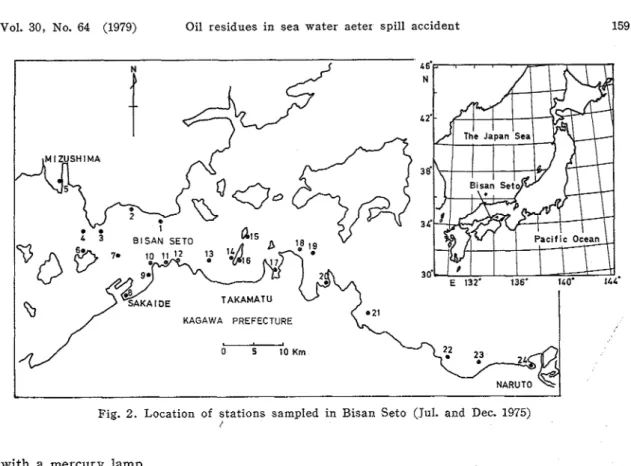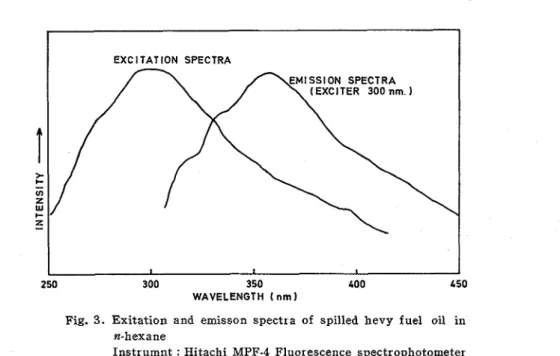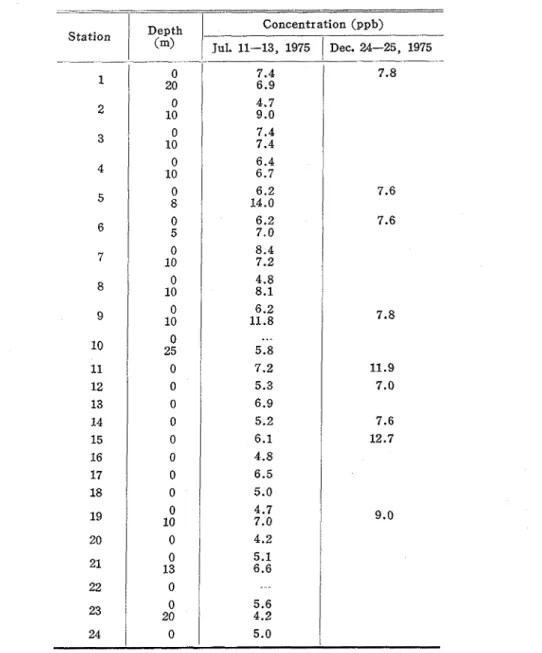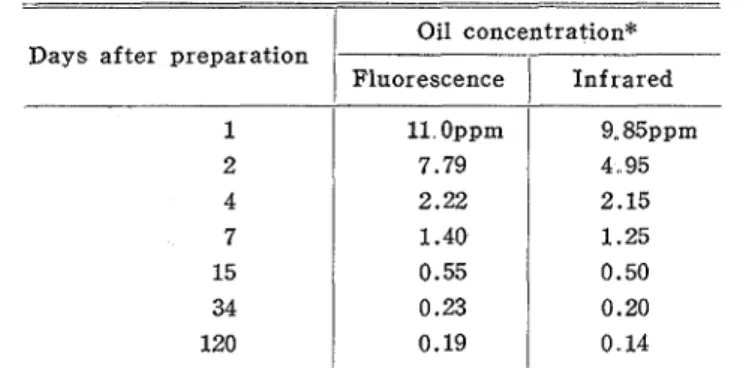Tech. Bull. Fac. Agr. Kagawa Univ. Vol. 30, No. 64 157-162, (1979) 157
DRIFTS OF OIL RE5IDUES IN SEA WATER OF BISAN S E T 0 AFTER
OIL SPILL ACCIDENT IN MIZUSHIMA, AS ASSESSED
BY
FLUORESCENCE SPECTROPHOTOMETRY
Tadashi OCHI and Tomotoshi OKAICHI
Oil residues in sea waters of Bisan Seto were measured by fluorescence spectophotometry after the oil spill accident at Mitsubishi Oil Refinery in Kurashiki city on December 18,1974. In the region of Kagawa Prefecture, the oil was present up to 1,500 ppb, mainly in dispersed form and partially in dissolved form, 12 days after the accident. At 7 months after, oil concentration decreased to close to the background value in the Seto Inland Sea, i.
e.
5 to 10 ppb. Some problems in measuring the background value of oil in the sea water were discussed in comparisons with the micro-fluorescence spectrophotometry and infrared spectrophotometr y.1974q12Fj 18B, @&$7hhE =I Y Y f.
-
1.. a33%;E;&fIl h k a , D C C&iIffl&s$jBFBc$E& Lt:. 5 D & 1@Pa,
7k@?&53&EDEiL&%jt%TB11% Lt:. 5a3%Ria,
3
& f I h h 12s
@ ~ ) f l B e z , % ~ \ - C % J I I L % D ? A ~ W D ~ E ~ ~ $tcEg
1,500ppb a3&h;b$&ttiShfi.Zhblk~f~fiiSf$@%8ETitj.~7':t#B$h9
7 .Ir'A&bZC2%?iBuP%D/fr 33"s
7 F @Ti%= f:&,%bh&8~E?Ql 5 -10ppb 2T@/J: Lt:. Z Qll$.ttg&.L$< $llR Sfi6%fi#@53#fi?&BCd: 6?J4B@D8& 1/20TLQl&bZ->b~TQ !&@&3J L k .Introduction
Oil pollution of waters became a problem of major importance during the past decate. A large amount of crude oil was frequentry spilled into the sea as a result of accidents to tankers and oil wells. On December 18, 1974, an oil strage tanke was suddenly broken up at Mitsubishi Oil Refinery in the Mizushima Combinat, Kurashiki city in Japan. The amounts of heavy fuel oil leaked out into the sea were estimated to be 7,500-9,000 K1. The greater parts of the oil were rapidly casted ashore by northwestern wind in this season and stained the coast line of Bisan Seto and the southern Harima Nada. As the results, coastal fisheries and aquacultures of yellowtails, lavers (Porphyra tenella). and Wakame seaweeds suffered damages exceeding 10,000 million yens in total. Furthermore these events remained possi- bility of longterm baneful influences of the oil pollution to marine ecosystem, even though the concentration of oil residues decreased to the level of ppb order.
This paper described changes in the levels of oil residues in the sea water of Bisan Seto Contribution from t h e Aji Marine Reseach Station, Fac. Agric. Kagawa Univ., No. 15.
158 Tadashi OCHI and Tomotoshi OKAICHI Tech. Bull. Fac. Agr. Kagawa Univ. after the spillage of heavy fuel oil from Mizushima Combinat. The investigations were continued for one year, when the oil concentration decreased to the level of background.
Materials and methods
Oil concentrations in the sea water were measured eight times at appropriate intervals after the accident, and three representative results of the investigations were shown in this paper. Sea water samples were collected in six stations indicated in Fig. 1 for the first investigation on December 30, 1974, and twenty four stations in Fig. 2 for the second investigation on July 11 to 13,1975. Based on the results of the second investigation the nine stations in Fig. 2 were selected for the sample collection of the third investigation on December 23 to 24, 1975.
Fig. 1. Distribution of heavy oil in dispersed and dissolved f o ~ m i n surface and bottom waters of Bisan Seto, the Seto Inland Sea (Dec. 30, 1974)
S : surface water B : bottom water
Immediately after the collection, 800 ml of the water sample was put into a grass bottle, stored at O°C until analysis. The sample was transfered to a 1 liter-separatory funnel from the sample bottle. The bottle was rinsed with 20 ml of methylene chloride and the solvent washing was added to the separatory funnel. The funnel was vigorously shaken for 1 minute and organic layer was transferred to a distilling flask, The water layer was washed with 20 ml of methylene chloride repeatedly and the washings were combined. The combined extract was evaporated to dryness by a rotary evaporator a t 30°C. The residue was dis- solved in 5 ml of n-hexane and fluorescent intensity of the solution was measured with exitation a t 315 nm, emission a t 365 nm by a Hitachi 204 fluorescence spectrophotometer
Vol. 30, No. 64 (1979) Oil residues in s e a water a e t e ~ spill accident 159
Fig. 2. Location of stations sampled i n Bisan Seto (Jul. and Dec. 1975) /
with a mercury lamp.
Standard oil solution for calibration of oil contents in the samples was prepared by dissolving the spilled oil in n-hexane. The spilled oil was offered through Mitsubishi Oil Rifiner y and was commercially termed a s "Desulfurized Topped Crude Oil".
Changes in oil concentration in the sea water were also examined on laboratory condition. Fifteen liters of surface water were collected a t Station 18 on July 1975. The water sample was filtered through 0.45 pm Millipore filters, placed in a 20-liter grass bottle with a bottom outlet, to which 40 g of the spilled oil were added and shaken for 30 minutes. The bottle was allowed to stand in a laboratory condition. The water sample was drawn out 7 times within 120 days and the oil concentration was analyzed by the fluorescence method and also by the infrared method at absorbance of 2,920 cm-1 with carbon tetrachloride.
Results a n d discussion
Infrared spectrophotometry by MALLEVIALLE (1973) ( * ) , AHMED (1974) ( I ) , ultraviolet spec- trophotometr y by LEVY (1971) (6), and gas chromatography by JELTES (1969) ( 3 ) are usually
applied as well-suited methods for the determinations of oil residues. But these methods are not available to the determination of low conckntration under 0.1 ppm. Fluorescence spectrophotometry which was reported for the detection 1 pg of oil in one liter of sea water by
KEIZER
and G o R D o N ( ~ ~ ~ ~ ) ( 4 ) seemed to be suitable to monito~ the low concentration.Exitation and emission spectra of the spilled oil in n-hexane are shown in Fig. 3. The overall recovery of extraction with methylene chloride was 85_t5%. The emission intensity was liner a s a function of oil concentrations between 1 and 200 pg/l.
Tadashi OCHI and Tomotoshi OKAICHI Tech. Bull. Fac. Agr. Kagawa Univ.
EXC l TAT ION SPECTRA
(EXCITER 300nm 1
t
> I--
V) Z W I- f I I I 250 300 350 400 450 WAVELENGTH ( nm 1Fig. 3. Exitation and emisson spectra of spilled hevy fuel oil in n-hexane
Instrumnt : Hitachi MPF-4 Fluorescence spectrophotometer
I n surface and bottom sea waters near the outlet of spilled oil in Mizushima harbor, oil concentrations were 60 and 10 ppb, respectively. In the region of Kagawa Prefecture, oil concentrations in the surface were widely ranged between 50 and 1,500 ppb, depending on the sampling stations. Those marked differences in the surface waters among the stations may be due to the inhomologous distributions of the oil suspension in water. Bottom waters were found to contain low concentrations of oil residues from 10 to 50 ppb. The floating oil slicks and chocolate mousses were still visible on the sea surface at almost all stations.
On July 11,-13, 1975, the most oil casted ashore was removed by human power and the oil slicks were not visible a t the most stations, except at Station 1,6 and' 9. As shown in Table 1 , the samples of the surface waters and almost all of the bottom waters remained in level from 4 to 9 ppb of the oil residues. Only two water samples of the bottom contained more than 10 ppb.
On December 23-24, 1975, one year after the oil spillage, two water samples contained more than 10 ppb and other samples contained less (Table 1).
The present study clearly demonstrated that the contents of oil residues in Bisan Seto were high during 3 or 4 months after the oil spillage, but after that, the contents decreased in short span of day. I t seemed that dispersed and dissolved forms of oil were removed by coprecipitation with another suspended solid and or refloat, cast ashore. Because the analysis of spilled oil which was added to filtered sea water with shaking for 30 minutes and allow to stand for 2 days showed 11,000 ppb of total amount. This solution was filtered through Millipore filters, however the oil residues in the filterate was only 50 ppb. This indicated that the oil detected in surface water was mainly of particulate forms.
The background level of oil residues in these sea area was assumed to be ranged from 5 to 10 ppb, which was in good agreement with the value in Chedabacto Bay reported by LEVY
and WALTON (1975) ( 7 ) . However, the values obtained through our investigations were
Vol. 30, No. 64 (1979) Oil residues in sea water after spill accident Table 1. Oil concentration i n sea water of Bisan Seto
Concentration (ppb) Jul. 11-13, 1975
(
Dec. 24-25, 1975reported by K u w ~ ~ ~ ( 1 9 7 5 ) ( 5 ) . Table 2 compares the experimental results obtained by the
fluorescence and those by the infrared methods. The values by the both methods agreed very well a t relatively high oil concentrations, when the original sea water which was esti- mated to be 3 ppb by the foremer method gave lOOppb by the latter method. Perhaps the value obtained by infrared method was affected by all extractable organic matters contained aliphatic chaines with carbon tetrachloride.
In a previous paper, we(1978) (2) confermed that this method is satisfactory i s satisfactory in term of sensitivity and rapidity to measure oil residues in sea water, although fluorescent components in oil may be variable by weathering and microbial action. In this study, therefore, we employed this method.
Tadashi OCHI and Tomotoshi OKAICHI Tech. Bull. Fac. Agr. Kagawa Univ. 11 Oppm 7.79 2.22 1.40 0.55 0.23 0.19
Table 2. Changes of oil concentration in sea water measured by fluorescence and infrared spectrophotometries with time
*
The values a r e corrected by the reduction of the background values in filtered sea water which were 0.003 ppm with fluorescence and 0.10 ppm with infrared spectr ophotometries.Days after preparation
Acknowledgement
Oil concentration* Fluorescence
/
Infr aredThe authors express their hearty thanks for kind assistance and cooperation given by the scientists and crew members of the survay boat Yakuri of the Kagawa Prefectural Fisheries Experimental Station. Thanks are also due to Mr. Kazuyuki OKUMURA for his technical assistances. This reseach was supported in part by a grant from the Scientific Reseach Fund of the Ministry of Education of Japan.
References
(1) AKMED, S. M., BEASLEY, M.D., e t al. : Sam-
pling errors i n the quantitation of petro- leumin Boston in Harver water, Anal. Chem., 46, 1858-1860(1974)
.
( 2 ) OCHI, T., OKAICHI, T. : Identification of crude oil and weathered oil of Mizushima Oil Spill by high speed gel permeation chromatography, Tec. Bull. Fac. A g r . K a gawa Univ., 29, 291-296 (1978).
( 3 ) JELIES, R. : Gas-chr omatogr aphic deter min-
ation of mineral oil in water, Water Res.,
3 , 931-941(1969).
( 4 ) KEIZER, P. D., GORDON, Jr. D. C. : Detection of trace amounts of oil in sea water by flu- orescence spectroscopy, .J. Fish. Res. Board Can., 30, 261-267 (1973).
( 5 ) KUWATA, H. : Determination of petr oleums, in "Studies on the influences of heavy oil
spill to marine ecosystem in the eastern part of the Seto Inland Sea" ed. by OKAICHI, T., Report to the Ministry of Education,
13-35(1976).
( 6 ) LEVY, E. M. : The presence of petroleum residues off the east coast of Nova Scotia, in the Gulf of St. Lawrence, and the St. Lawrence river, Water R e s , 5, 723-733
(1971).
( 7 ) LEVY, E. M., WALTON, A. : Dispersed and particulate petroleum residues in the Gulf of St. Lawrence, J, Fish. Res. Board Can., 30, 261-267(1973)
.
( 8 ) MLLEVIALLE, J. : Measux ment of hydr ocar -
bon in water, Application t o cases of surface water pollution, Water Res., 8, 1071-1075 (1973).




